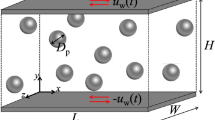Abstract.
The transition from solid-like to liquid-like behavior of suspensions of monodisperse spherical particles in a Newtonian continuous phase with varying solid volume concentrations and particle sizes was investigated in rotational shear flows. It was found that the solid-liquid transition takes place in a relatively narrow shear stress range, where the corresponding shear strain γ and the shear rate \( \dot \gamma \) , respectively, increase over some orders of magnitudes. Below the transition region the material behaves like a nonlinear elastic solid with an initial linear range, i.e., \( \gamma = f\left( \sigma \right) \) . The transition depends on the type of the shear loading and on the solid volume concentration. At high shear rates a nonlinear viscous behavior (\( \dot \gamma = f\left( \sigma \right) \) ) with a terminal Newtonian range \( \dot \gamma = {\sigma \mathord{\left/ {\vphantom {\sigma \eta }} \right. \kern-\nulldelimiterspace} \eta } \) was observed, if the solid volume concentration is below a critical value. Above this value the material behaves like a moist bulk solid material.
Similar content being viewed by others
Author information
Authors and Affiliations
Corresponding author
Additional information
Electronic Publication
Rights and permissions
About this article
Cite this article
Heymann, L., Peukert, S. & Aksel, N. On the solid-liquid transition of concentrated suspensions in transient shear flow. Rheol Acta 41, 307–315 (2002). https://doi.org/10.1007/s00397-002-0227-1
Received:
Accepted:
Published:
Issue Date:
DOI: https://doi.org/10.1007/s00397-002-0227-1




